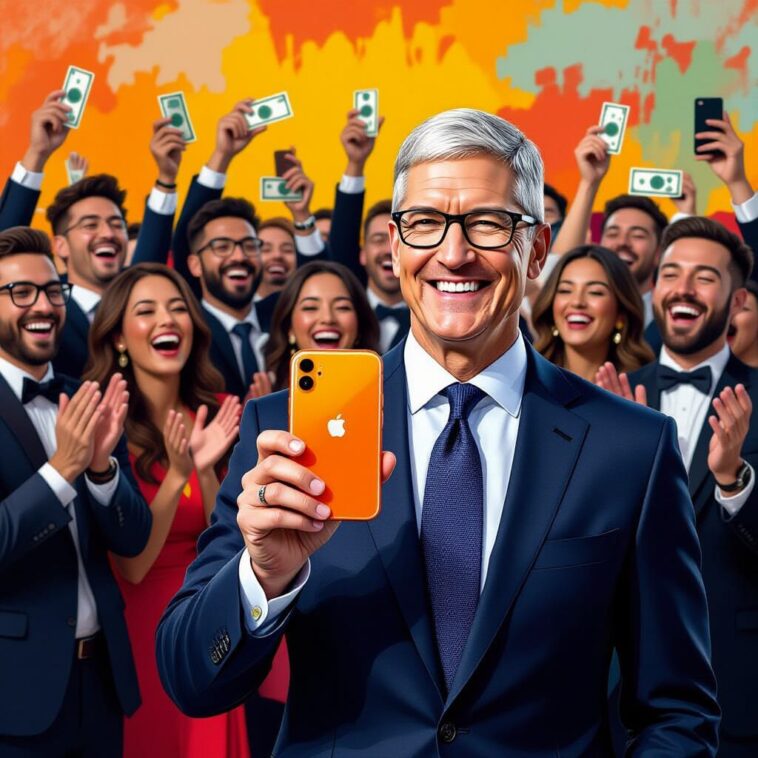It was the best of times for Apple shareholders, it was the worst of times for anyone who actually wanted their iPhone to survive a gentle breeze. In the gleaming towers of Cupertino, where the air is thick with the scent of liquid courage and premium pricing strategies, a revolution was brewing. Not the kind that might cure cancer or solve climate change—heavens NO—but the kind that truly matters: making iPhones so thin they could be used as credit cards, if credit cards cost $1,200 and shattered when you looked at them sideways.

The iPhone 17 Air, according to whispers from the supply chain prophets in China; will measure a breathtaking 5.5 millimeters in thickness. To put this in perspective, that’s thinner than the average human fingernail, which seems fitting since users will need to handle it with the delicacy typically reserved for butterfly wings or Tim Cook’s ego when someone mentions actual innovation.
This represents a quantum leap backward from the iPhone 6, which at 6.9 millimeters was apparently still unconscionably thick for modern sensibilities. Those extra 1.4 millimeters were clearly the barrier preventing humanity from achieving true enlightenment. Finally, Apple has removed this burden from our pockets and our souls.
The Shareholder Spring
In the boardrooms of institutional investors, there is great rejoicing. Stock analysts are positively giddy at the prospect of charging premium prices for engineering that prioritizes form over function with such breathtaking audacity. “Innovation,” they cry, while their PowerPoint presentations show graphs trending ever upward, much like the brittleness coefficient of Apple’s latest creation.
Tim Cook, master of the balance sheet ballet, has perfected an art form more sophisticated than product development: financial engineering. While other companies waste time on trivial pursuits like artificial intelligence breakthroughs or revolutionary user interfaces, Apple has discovered the secret to sustainable growth—make the same thing, but thinner, and occasionally change the color.
The Vision Pro, that magnificent experiment in charging $3,500 for the privilege of wearing a computer on your face while looking like a lost extra from a science fiction film, has been quietly shuffled into the corner like an embarrassing relative at a family gathering. No matter. The future isn’t in revolutionary computing paradigms—it’s in phones so thin they can double as bookmark technology.
The Tale of Two Apples
There exists, in this curious ecosystem, two distinct species of Apple enthusiast. The first inhabits the rarified air of earnings calls and shareholder meetings, where they speak in hushed, reverent tones about “margin expansion” and “premium positioning.” They have never dropped an iPhone, because they have never held one—their devices are carried by assistants who specialize in the delicate art of phone handling.
The second species dwells in the real world, where gravity exists and phone cases are sold in every corner store like medieval armor for digital devices. They are the ones who will ultimately purchase these architectural marvels of fragility, who will cradle them like newborn infants, who will develop carpal tunnel syndrome from the stress of constant protective vigilance.
Between these two worlds lies a chasm wider than the iPhone 17 Air is thin. In one realm, the quest for impossible thinness represents the triumph of design philosophy over practical consideration. In the other, it represents the triumph of marketing over basic physics.
The Chronicles of Bendgate 2.0
Those with long memories will recall the iPhone 6’s delightful tendency to achieve new geometric configurations when subjected to the extraordinary stress of being placed in a front pocket. That device, at a robust 6.9 millimeters, occasionally transformed itself into a gentle curve that some called “art” and others called “warranty replacement.”
The iPhone 17 Air, at 5.5 millimeters, promises to elevate this experience into performance art. Imagine the possibilities: phones that bend not just from pocket pressure, but from the weight of your thumb on the screen. Devices so delicate that taking them outdoors requires consideration of wind conditions. The excitement is palpable.
Apple’s response to concerns about structural integrity will undoubtedly involve a masterclass in blame transference. The phones aren’t too thin—users are too rough. The devices aren’t fragile—the world is too harsh. This isn’t a design flaw—it’s a feature that encourages mindfulness and present-moment awareness through constant anxiety.
The Orange Revolution

In what can only be described as a stroke of pure genius, Apple has reportedly decided to add orange to their color palette. Orange! The color of traffic cones and safety vests, now available for your pocket-sized digital companion. Nothing says “premium lifestyle accessory” quite like the hue typically associated with highway construction warnings.
This represents the cutting edge of Apple’s innovation pipeline: chromatic experimentation. While competitors waste resources on artificial intelligence capabilities or revolutionary battery technology, Apple focuses on the truly important questions. Not “How can we make this device more useful?” but “How can we make it more orange?”
The marketing campaign writes itself: “Think Different. Think Orange. Think Fragile.”
The Liquid Glass Prophecy
Industry insiders whisper of something called “liquid glass” technology, a new kind of experience when using the iPhone. It sounds precisely like the kind of meaningless technical poetry that Apple’s marketing department crafts in their sleep. Liquid glass—presumably regular glass that has achieved a fluid state of mind, or perhaps glass that identifies as a liquid, or maybe just glass that costs more because it has an adjective in front of it.
This liquid glass will apparently be the star of Apple’s next theatrical production, because when you’re struggling to justify charging flagship prices for incremental improvements, you need materials that sound like they were discovered in a fantasy novel. Regular glass is for peasants. Liquid glass is for visionaries who understand that the word “liquid” adds at least $200 to the retail price.
The Ecosystem of Accessories
The true brilliance of the iPhone 17 Air’s ultra-thin design becomes apparent when one considers the vast ecosystem of protective accessories it will necessitate. Phone cases will no longer be optional fashion statements—they’ll be essential life support systems. The case industry is preparing for a renaissance of unprecedented proportions.
Imagine the possibilities: cases thicker than the phones they protect, creating a beautiful irony where the solution to thinness is thickness. Screen protectors that cost more than the phones they’re protecting, because replacing a shattered liquid glass display will require taking out a small loan. Insurance policies that specifically exclude “acts of gentle handling.”
This is ecosystem thinking at its finest—create a problem, then sell the solution. Create devices so delicate that they require an entire support network of protective accessories, specialized handling procedures, and perhaps trained professionals who can safely transport them from the store to your pocket.
The Great Thinning
The iPhone 17 Air represents more than just another product launch—it represents a philosophy. In a world plagued by complex problems that resist simple solutions, Apple has identified one area where they can achieve absolute victory: the war against thickness. Every millimeter conquered brings us closer to the ultimate goal—phones so thin they exist only in theory.
The implications extend far beyond mobile technology. If thinness is the ultimate virtue, what’s next? Laptops so thin they require magnifying glasses to locate? Watches so thin they’re technically jewelry? Cars so thin they can only accommodate passengers who have been professionally flattened?
This is innovation in its purest form—the relentless pursuit of a single metric, regardless of practical consequences or user benefit. It’s beautiful in its simplicity and terrifying in its implications. Apple has found the secret to eternal growth: identify one measurable characteristic, then optimize it to absurd extremes while charging premium prices for the privilege.
Have you ever wished your phone was more fragile? Do you find current smartphones insufficiently likely to shatter from gentle handling? And most importantly—are you ready to pay premium prices for the privilege of constant anxiety about your device’s structural integrity? When did we decide that making technology more delicate was the same thing as making it better?





GIPHY App Key not set. Please check settings